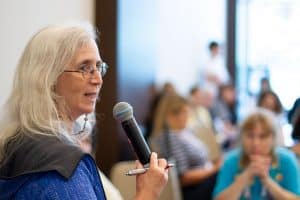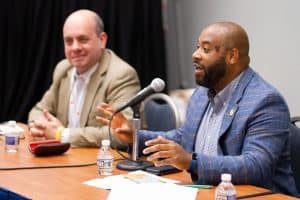
When we talk about making our libraries and schools accessible, Liz Johns, teaching and learning librarian at Goucher College in Towson, Maryland, emphasizes: People are not problems.
“We often frame [disability or accessibility] as a problem, something to overcome, or something to deal with,” she told attendees at “Accessibility and Creation of Online Library Materials: Applying Universal Design for Learning (UDL),” a June 22 session at the American Library Association’s 2019 Annual Conference and Exhibition in Washington, D.C. Johns chooses instead to use positive, person-first language—not deficit language.
“Making changes to our teaching isn’t always the message we want to hear, but it should be an exciting challenge,” Johns said. “It’s a little bit of work, but it’s work up front.”
Johns and her colleagues spoke in support of UDL, a framework intended to improve and optimize teaching and learning experiences for all people, regardless of background or abilities, based on scientific insights into how humans learn. UDL is not one-size-fits-all, a new instructional method, or a specific technology solution; UDL is a broader way of thinking.
“There’s no step-by-step guide,” says Johns. “Taking a proactive and inclusive approach benefits all learners.”
For Johns, being proactive means not falling back on an accommodation model. An example of this would be allowing a student with dyslexia more time on a test. A reactive response doesn’t always provide an equal experience, and it excludes students who don’t self-identify.
“What about using Arial or Verdana font to mitigate challenges for kids with dyslexia?” Johns asks.
There are many other considerations faculty could be addressing when it comes to accessibility. Rebecca Oling, interim director of digital accessibility at SUNY Purchase College in Harrison, New York, provides instructors with training on online object creation and audits their course materials from a UDL lens. “After I meet with them, I send them an organized digital review,” she explained.
“Coming from an abled perspective, a perspective of privilege, it really does take [instructors] time to move the needle a little bit,” said Oling. “I didn’t expect the embarrassment and shame [they would feel] about the state of their content.” Oling explained that, after their course materials were audited for accessibility, some staffers expressed concern about the barriers that may have existed in their courses and the students who may have “fallen through the cracks.”
Oling wants her faculty to move toward instructional materials that are simple, minimalist, consistent, intentional, transparent, and require little effort. Teressa Keenan, head of bibliographic management service and accessibility liaison at University of Montana, presented some ideas on how to do that, from how to organize documents to designing PowerPoint presentations to using consistent hyperlinks to always providing an alternative to media content.
“Designing objects [to be accessible] from the very beginning is easier to do than trying to fix it later,” said Keenan. “Don’t beat yourself up if it takes a while to get where you’re going. Just keep moving forward.”
Amanda Roth, instructional technologies librarian at UC San Diego, also warns: “Just because it’s accessible doesn’t mean it’s great learning.” When it comes to course material, “you have to test it,” she said. At her institution, students with disabilities—the actual users of a course’s materials—are often asked for their feedback on online objects.
Looking to get started with UDL at your library? “It really starts with the way you write your learning outcomes,” Roth said. “It just becomes habit.”


